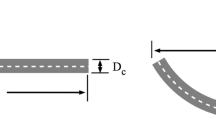Summary
This paper describes measurements of the impulses that particles experience while undergoing rapid shear. These were performed with an eye towards understanding the processes that lead to particle attrition and fracture. The measurements were taken from a discrete particle computer simulation of a simple shear flow of spheres. Special attention is paid to the strongest impulses as these will do the most damage. The results indicate that the largest impulses arise, not from the mean shear flow, but from the random particle velocities that are characterized by the so-called “granular temperature”. Measurements of the largest impulses are presented as functions of particle properties and solid concentration. Histograms of the impulse strengths illustrate the effect of concentration and particle surface friction. Finally, geometric distributions are presented that illustrate the shear induced anisotropy in the impulse strengths.
Similar content being viewed by others
References
Boldyrev, V.V.: Mechanical activation of solids. Report to the Annual Meeting of the International Fine Particle Research Institute 1992
Campbell, C. S.: Shear flows of granular materials. PhD thesis and Report E-200.7, California Institute of Technology 1982.
Campbell, C. S.: The stress tensor for simple shear flows of a granular material. J. Fluid Mech.203, 449–473 (1989).
Campbell, C. S.: Rapid granular flows. Annu. Rev. Fluid Mech.22, 57–92 (1990).
Campbell, C. S.: Boundary interactions for two-dimensional granular flows. Part I. Flat boundaries, asymmetric stresses and couple stresses. J. Fluid Mech.247, 111–136.
Campbell, C. S., Brennen, C. E.: Computer simulation of granular shear flows. J. Fluid Mech.151, 167–188 (1985).
Campbell, C. S., Brennen, C. E.: Chute flows of granular material: some computer simulations. Trans. ASME J. Appl. Mech52, 172–178 (1985).
Campbell, C. S., Gong, A.: The stress tensor in a two-dimensional granular shear flow. J. Fluid Mech.164, 107–125 (1986).
Hanes, D. M., Inman, D. L.: Observations of rapidly flowing granular fluid flow. J. Fluid Mech.150, 357–380 (1985).
Heyes, D. M.: The nature of extreme shear thinning in simple liquids. Mol. Phys.57, 1265–1282 (1986).
Isherwood, P.: Personal communication, 1989.
Jimbo, G., Zoo, Q. Q., Yokoyama, T., Taniyama, Y.: The grinding limit and the negative grinding phenomenon. In: Proc. Second World Congress on Particle Technology, pp. 305–312, Kyoto, Japan 1990.
Savage, S. B., Sayed, M.: Stresses developed by dry cohesionless granular materials in an annular shear cell. J. Fluid Mech.142, 391–430 (1984).
Author information
Authors and Affiliations
Rights and permissions
About this article
Cite this article
Campbell, C.S. Impulse strengths in rapid granular shear flows. Acta Mechanica 104, 65–90 (1994). https://doi.org/10.1007/BF01170277
Received:
Issue Date:
DOI: https://doi.org/10.1007/BF01170277




